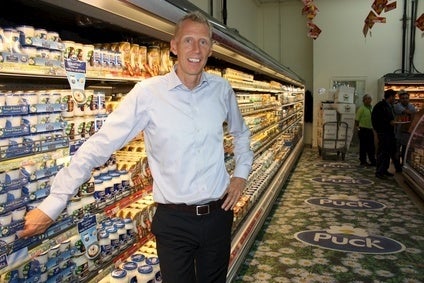
After Arla Foods booked a jump in sales last year – pointing to the performance of its “growth markets” outside the EU – the dairy giant has rolled out plans to further expand its operations outside Europe. just-food’s Hannah Abdulla caught up Rasmus Malmbak Kjeldsen, director of operations for Arla’s business in the Middle East and Africa to find out what the company has planned for the region.
Arla Foods has had a presence in the Middle East for more than 50 years and has grown significantly since it first set foot into the region. In 2005, Arla set up operations in Saudi Arabia but, three years later, it set up its regional HQ in Dubai.
Speaking to just-food on the sidelines of this year’s Gulfood expo in Dubai, director of operations for Arla’s business in the Middle East and Africa Rasmus Malmbak Kjeldsen says the company chose the city as it “serves as the perfect hub in terms of getting around”.
Many multinationals who have their base in Dubai have commented there is a certain ease in trading from there. And local supermarket chain Choithrams told just-food the governing authorities in the UAE enable foreign entities to invest into the market “with certain liberties you would not get elsewhere in the GCC”.
And Dubai, with its waves of foreigners visiting and working in the city, has a more transient consumer base which works in Arla’s favour.
In 2013, of all Arla’s consumer international business, the Middle East occupied the highest share. The branded business has doubled since 2006 and continues to take “market share from the closest competitors”. In the Middle East, Arla holds a third of the cream cheese and butter market, impressive considering its competition comprises multinational heavyweights like FrieslandCampina and local dairy giants such as Almarai.

US Tariffs are shifting - will you react or anticipate?
Don’t let policy changes catch you off guard. Stay proactive with real-time data and expert analysis.
By GlobalDataThis year, the firm outlined a DKK750m investment into its production in “strategic growth markets” compared with DKK466m a year earlier. These include Russia, China – and the Middle East and Africa. By 2017, Arla wants 20% of its total revenue share to come from these markets, with a strong emphasis on North Africa. The firm has outlined plans to move 1bn kg of milk outside Europe. The Middle East has been a key part of that goal especially after this year when Arla realised revenue growth of 10% to DKK3.3bn in the region.
“Part of that investment will go into our product facility in Europe so they can keep up with our demand,” explains Kjeldsen. “Secondly, we are looking at how we can build stronger partnerships in west and north Africa. We are now looking to Egypt and Libya for where we want to establish ourselves that investment will go towards building an infrastructure and plant, and spending more on marketing ourselves in those areas.”
Pouring money into bettering its operations is not something new for Arla and as Kjeldsen points out, it is something that has had to be done in order to do business in a sector where competition “is quite fierce”.
“Arla has its focused brands and we build strength into these. We’ve been in the region for so many years, we know the consumer and we have spent a lot of money getting to know what they want,” says Kjeldsen.
Arla has been clear on its Middle East and African market product portfolio. Kjeldsen explains that one of the reasons it has the upper hand over its competitors is because its products are “tailored to the Arabic consumer”.
“We make good, high quality products. Our butter Lurpak, and some of our cheeses I would argue, are still slightly ahead of our competitors in these categories.
“We decided early on we didn’t want to play in fresh; anything with a short shelf-life, we don’t do here. We do juices, longlife cream and milk powder.”
Arla also produces “snacking” items, which Kjeldsen says are “between cheese and products”.
“We launched part of the range already - the dairy sticks with a very mild cheese flavour – and now we are working on the full range of these for the African consumer.”
But creating an innovative line comes at a cost and one of the obstacles Arla has come up against in the Middle East is that of the enforcement of fixed prices.
“In the Middle East you find price-increase restrictions. Since dairy prices have shot up, it becomes very difficult. It’s a huge challenge in this market.”
Another reason many global players are put off stepping into the Middle East is the issue of political instability which often means the regional industry has difficulty “convincing” outside firms of its growth potential.
Arla is still convinced it is worth pressing forward with plans to grow in the region. In its annual 2013 statement, Arla said, in a rather understated manner, said the Middle East and Africa looked “promising”.
During 2013, Arla’s organic revenue growth across the Middle East and Africa was up 11.6% By 2017, Kjeldsen says Arla is looking at revenue for the whole of the region to grow by 16% a year, from which he believes “a major part” will come from “maturation in the north African markets as the firm continues to focus on this area.
While he predicts trade to grow by 20%-25% across Africa in the next four years, the Middle East he believes will continue to see growth, but at a steady pace of 11-12%.



